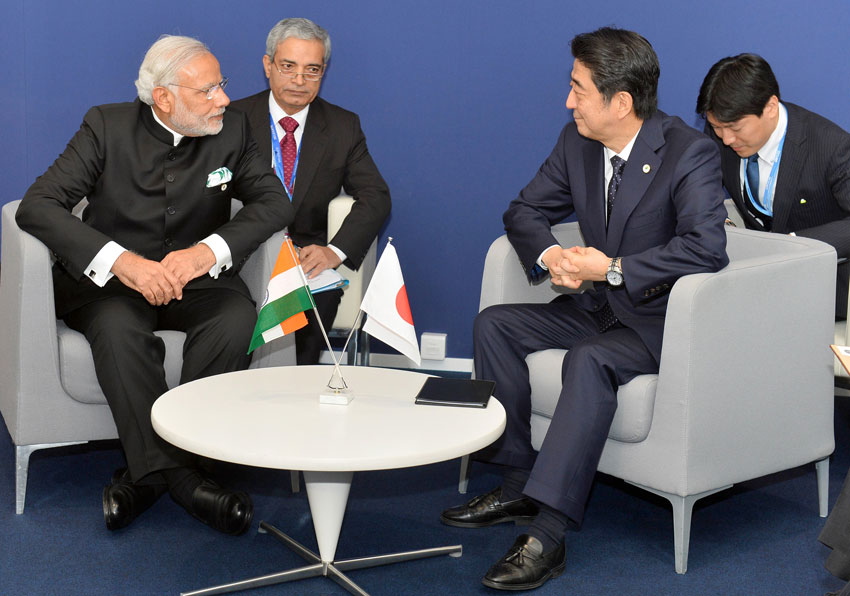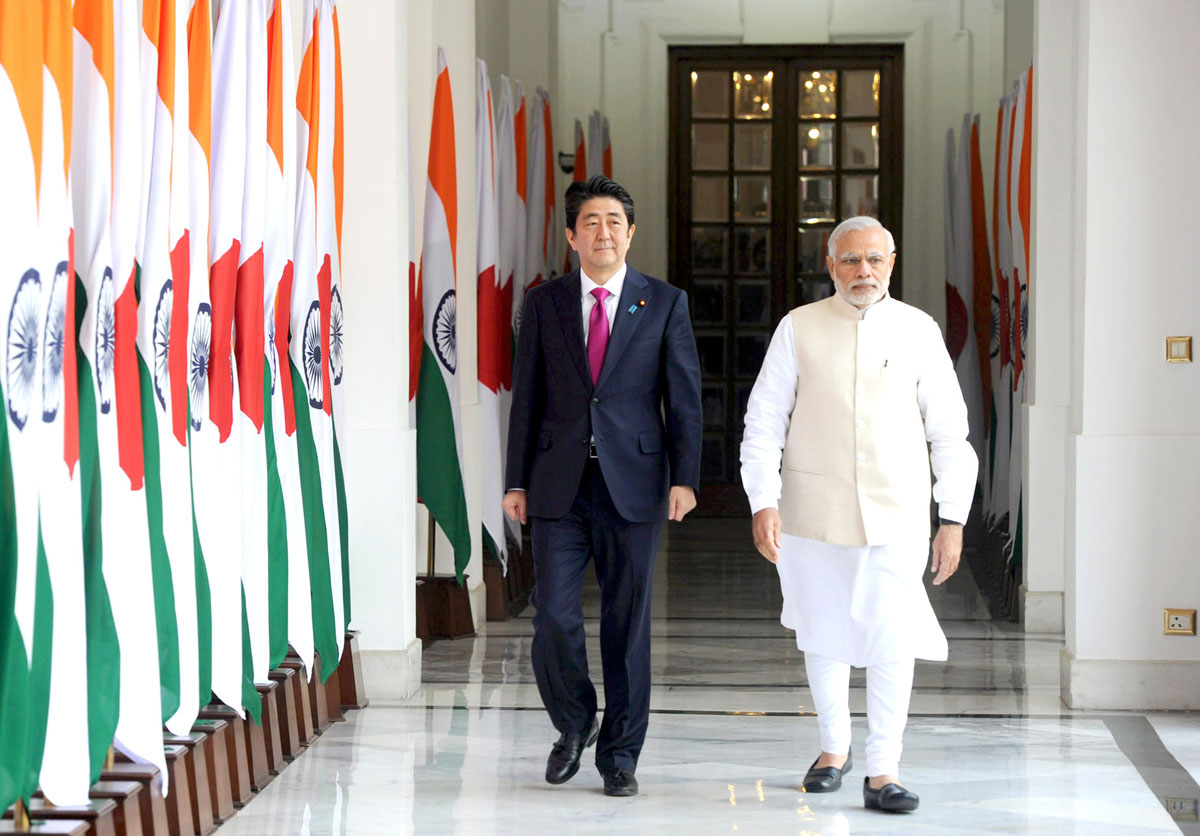SOARING AHEAD
Prime Minister Narendra Modi with Japanese Prime Minister Shinzo Abe, at Hyderabad House, in New Delhi, Dec. 12. (Press Information Bureau)
Prime Minister Narendra Modi and his Japanese counterpart Shinzo Abe’s personal ties date back to 2007. The bonhomie and understanding at the top is translating into concrete action as relations between the two countries have moved forward considerably, writes Siddharth Srivastava. (#Politics, #IndiaJapanTies, @narendramodi, #ShinzoAbe, #IndianEmbassyUSA, #Siliconeer, @Siliconeer)
Over the recent past India and Japan have increasingly sought each other as natural allies to neutralize the economic and military hegemony of China in the Asian region. Apart from strategic and geopolitical aspects, the two nations are also looking to compliment each other in promoting business ties. India is seeking Japan’s role in financing big-ticket projects.
Japan, on the other hand, sees immense potential in tapping the growing Indian market in order to reduce its reliance on China as its biggest customer. Last month, Abe was in India, hosted by Modi. The two leaders spent some quality time and light moments on the banks of the River Ganga in Varanasi, the constituency that Modi represents in the Lok Sabha.
In New Delhi, Modi and Abe inked major agreements seen as some of the biggest steps taken to deepen relations between the two nations. “I cannot think of a strategic partnership that can exercise a more profound influence on shaping the course of Asia and our interlinked ocean regions more than ours,” Modi said at a joint news conference with Abe. “In a world of intense international engagements, few visits are truly historic or change the course of a relationship. Your visit, Mr. Prime Minister, is one,” Modi added.
The highlights of Abe’s three-day visit were the following: a $15 billion deal under which Japan will assist India in building its first high-speed rail link of the bullet train; the two countries finally signed a civilian nuclear deal; $12.4 billion in Japanese financing and export insurance to boost investment in India; defense agreements that seek to contain China’s expansion in regional waters, especially the South China Sea and Japanese funds to build roads in India’s underdeveloped northeast, where China’s territorial claim over Arunachal Pradesh is a periodic flashpoint.
In a comment to news agency Bloomberg, Michael Kugelman, senior associate at the Woodrow Wilson Center in Washington, said, “Modi and Abe are telegraphing a striking message: We’re taking this relationship to the next level, even at the risk of roiling China. As close as these two countries are, they had held off to an extent in order not to overly alarm China.”

Nuclear Push
The biggest breakthrough, however, was the signing of a memorandum of understanding (MoU) on peaceful use of civil nuclear energy, following protracted negotiations that have lasted over five years. “The key part has been done,” India’s foreign secretary S. Jaishankar said. Japan’s concerns have been addressed by India’s self-imposed moratorium on nuclear tests, though Tokyo would reconsider the pact if the South Asian nation detonates an atomic device, foreign ministry spokesman Yasuhisa Kawamura told reporters in New Delhi.
As the only country in the world that has faced the horrors of atomic war, Japan has so far been averse to signing a civilian nuclear deal with India. This has been proving to be problematic for India. Due to ownership interlinkages between Japanese and U.S. atomic majors such as General Electric-Hitachi and Westinghouse-Toshiba, it was critical for India to seal agreements with both countries in order to import latest nuclear technology and services. After the signing of the MoU on atomic energy Modi said: “The MoU we signed on civil nuclear energy cooperation is more than just an agreement for commerce and clean energy. It is a shining symbol of a new level of mutual confidence and strategic partnership in the cause of a peaceful and secure world.”
Abe said the final agreement on cooperation “will be signed after the technical details are finalized.” India aims to increase its nuclear generating capacity from the current 5,800 MW to 27,500 MW by 2032. Following the Indo-Japan nuclear deal, reports quoting officials have said that India will soon sign a contract with Westinghouse Electric to build six nuclear reactors in the first half of 2016.
India’s long seclusion from international nuclear trade ended in 2008 when the Nuclear Suppliers Group granted the country an exemption, despite being a non-signatory to non-proliferation and arms test ban treaties, that paved the way to the landmark India-U.S. civil nuclear agreement. The deal has provided the template for other countries to follow. India has since signed atomic cooperation agreements with Australia, Canada, France, Kazakhstan, Russia, the UK and the USA. Recently, India received the first consignment of 250 tons of uranium from Canada. The two countries signed a civil nuclear deal in September 2013 which was followed by a contract between Canada’s Cameco and India’s Department of Atomic Energy during Modi’s visit to Ottawa in April 2015.
Canada, along with many other nations, ended all bilateral cooperation in atomic power with India following the country’s first nuclear weapons test in 1974. Cameco is contracted to supply about 2,730 tons uranium to India worth about $262 million, till 2020. The agreement can be extended beyond 2020. With Japan finally agreeing in principal to back India’s aims to generate nuclear power, a major bottleneck to progress has been removed.


